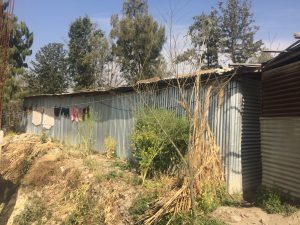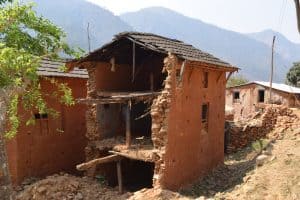Contributed by Maria Grazia Frontoso
At 11:56am on 25 April 2015, Central Nepal was hit by a massive earthquake (7.8 magnitude), causing devastation to many parts of the country. Luckily it happened when many people were not in their houses so the number of casualties was small compared to the number of destroyed or damaged houses.

Example of temporary shelter.
During the RMS Impact Trek in March 2017 I didn’t expect to see lots of houses still highly damaged neither many people (4 million) still living in temporary shelters. Almost 2 years after the earthquake! Rebuilding lost homes and livelihood is a slow and drawn-out process in an under-developed and bureaucratic country like Nepal.
For villages completely flattened by the earthquake rebuilding houses from scratch is the only option.
With a few issues:
- Construction codes are not always applied. “This is how it works in the informal economy: someone constructs a building without official authorization or planning approval. The builder meets an inspector in a café. Coffee is drunk and cigarettes are smoked, some money changes hands, and now there is a certificate to show that the building is ‘authorized’ and complies with the regulation (Robert Muir-Wood, The Cure for Catastrophe)”.
- There is a gap between construction code & real needs of people. This is because the components of building regulation are not integrated in a holistic manner, and there is no common set of risk or safety levels underpinning the building performance requirements.
- In very poor villages there is no clear ownership of land after the earthquake
- Homeowners are not consulted during the design & rebuilding process and are often assigned to a new house they don’t want to live in it.
For damaged houses a valuable option to consider is retrofitting, a series of techniques aimed at strengthening older buildings to make them more resistant. Retrofitting can be used for both damaged and non-damaged buildings, in the latter case for prevention.
The Government in Nepal seems to favor demolishing old damaged houses and building new houses. But people (especially in the villages) are not happy with this approach. Homeowners may not want to live in places where the new houses are built or cannot afford to live in a new-built house with same characteristics/dimensions of the previous one. For example, with the money provided by the Government it would be possible to build only a very small ‘safe’ house while homeowners are typically used to live in a big 3-story house (100m2), for hosting cattle, living and storing food.
Homeowners would just like to go back to their previous-but-safer house.

House in Eklephant (to be retrofitted).
But there is also a difference in risk-cost-benefit relationship between new and existing construction. Sometimes it is more cost-effective (or easier?) to implement risk mitigation measures when designing and constructing new buildings as compared to retrofitting existing buildings. So, the overall picture is quite complex.
Give a man a fish and you feed him for a day; teach a man to fish and you feed him for a lifetime.
This is, in a nutshell, how Build Change works: not building or retrofitting safer houses but instead teaching and transferring such knowledge to the local community, for a lifetime.
Build Change starts from the need and demand of the local population. New technologies are introduced during the retrofitting work but those technologies must be affordable in order to have a sustainable shift in building design & performance.
During the entire RMS Impact Trek, I looked at / thought of the many challenges of a poor country like Nepal affected by a natural catastrophe. With a single question in my mind: what can we do to make places like Nepal more resilient?

Kathmandu – Garden of Dreams.
I wish I have a panacea to share with all of you but starting with a few ideas of what can be a game changer:
- Build Change is contributing to include retrofitting in all the standard practices for safe buildings and is making a mindshift at the decision level to assess post-catastrophes damages. This is a long path but it will slowly put more attention on prevention rather than post-catastrophes from the public / private sectors and decision makers.
- RMS & the insurance industry can play a big role in jointly designing alternative transfer risks products, microinsurance, etc.. & entering new markets. While there is probably not enough demand for property insurance, agricultural insurance is a great potential to low-income farmers and their community. Market-based solutions could include providing lower premiums if farms have been retrofitted, for example. RMS & the insurance industry can benefit from the in-depth knowledge of the local community provided by Build Change.
- And you, reading this blog & listen to the experience of your colleagues, can bring awareness to the people around you, helping to bridge the protection gap and contributing to a more resilient society.
